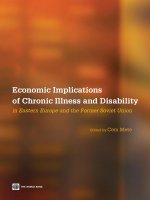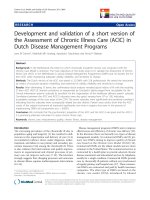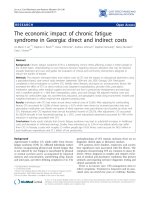Economic Implications Of Chronic Illness And Disability In Eastern Europe And The Former Soviet Union pptx
Bạn đang xem bản rút gọn của tài liệu. Xem và tải ngay bản đầy đủ của tài liệu tại đây (4.59 MB, 156 trang )
Economic Implications
of Chronic Illness and Disability
in Eastern Europe and the Former Soviet Union
Edited by Cem Mete
Economic Implications of Chronic Illness and Disability
Disability is an important issue for the transition countries of Eastern
Europe and the former Soviet Union. Not only is a significant portion
of their population either in poor health or disabled—with implications
for labor force participation and productivity—but their aging demo-
graphics project an increase in the share of disabled people, raising
concerns about the sustainability of social protection programs. Thus,
if these heavily resource-strapped countries fail to deal in an efficient
manner with disability and health issues in their population, they could
face serious challenges to their efforts to achieve stronger economic
growth and improved living standards.
Because the economic drivers and costs of poor health status and
disabilities in this region are not well documented, Economic Implica-
tions of Chronic Illness and Disability in Eastern Europe and the Former
Soviet Union aims to close this gap by leveraging household survey
data from a large number of transition countries, analyzing the poverty-
disability relationship and the linkages between disability and employ-
ment, earnings, children’s school enrollments, and adults’ time-use
patterns.
Altogether, disability appears to have stronger negative effects on
the economic and social well-being of the population in these countries
as compared with industrialized countries. The main reasons are the
prevalence of a large informal sector, the relatively weak targeting
performance of the existing social assistance programs, and the lack
of broad-based insurance mechanisms to protect individuals against
loss of income due to unexpected illnesses.
Addressing these weaknesses is the challenge facing policy makers
and the population at large in the region, through the definition and
enactment of a deep, well-coordinated, cross-sectoral reform agenda.
This book will be useful for policy makers and development officials
working to improve living standards in the Eastern Europe and the
former Soviet Union.
The World Bank
ISBN 978-0-8213-7337-8
SKU 17337
This study is part of a series undertaken by the Europe and Central Asia
region of the World Bank. The series draws on original data, the World Bank’s
operational experience, and the extensive literature on the Region. Poverty,
jobs, trade, migration, energy, and productivity will be among the topics covered.
This report is part of a series undertaken by the Europe and Central Asia Region
of the World Bank. The series covers the following countries:
Albania
Armenia
Azerbaijan
Belarus
Bosnia and Herzegovina
Bulgaria
Croatia
Czech Republic
Estonia
FYR Macedonia
Georgia
Hungary
Kazakhstan
Kyrgyz Republic
Latvia
Lithuania
Moldova
Montenegro
Poland
Romania
Russian Federation
Serbia
Slovak Republic
Slovenia
Tajikistan
Turkey
Turkmenistan
Ukraine
Uzbekistan
ECONOMIC IMPLICATIONS OF
CHRONIC ILLNESS AND
DISABILITY IN
EASTERN EUROPE AND THE
FORMER SOVIET UNION
ECONOMIC IMPLICATIONS OF
CHRONIC ILLNESS AND
DISABILITY IN
EASTERN EUROPE AND THE
FORMER SOVIET UNION
Edited by Cem Mete
2008 The International Bank for Reconstruction and Development / The World Bank
1818 H Street NW
Washington DC 20433
Telephone: 202-473-1000
Internet: www.worldbank.org
All rights reserved.
1 2 3 4 11 10 09 08
This volume is a product of the staff of the International Bank for Reconstruction and Development / The
World Bank. The findings, interpretations, and conclusions expressed in this paper do not necessarily reflect
the views of the Executive Directors of The World Bank or the governments they represent.
The World Bank does not guarantee the accuracy of the data included in this work. The boundaries, colors,
denominations, and other information shown on any map in this work do not imply any judgement on the part
of The World Bank concerning the legal status of any territory or the endorsement or acceptance of such
boundaries.
Rights and Permissions
The material in this publication is copyrighted. Copying and / or transmitting portions or all of this work
without permission may be a violation of applicable law. The International Bank for Reconstruction and
Development / The World Bank encourages dissemination of its work and will normally grant permission to
reproduce portions of the work promptly.
For permission to photocopy or reprint any part of this work, please send a request with complete informa-
tion to the Copyright Clearance Center Inc., 222 Rosewood Drive, Danvers, MA 01923, USA: telephone:
978-750-8400; fax: 978-750-4470; Internet: www.copyright.com.
All other queries on rights and licenses, including subsidiary rights, should be addressed to the Office of the
Publisher, The World Bank, 1818 H Street NW, Washington, DC 20433, USA; fax: 202-522-2422; e-mail:
ISBN-10: 0-8213-7337-4
ISBN-13: 978-0-8213-7337-8
e-ISBN-10: 0-8213-7338-2
e-ISBN-13: 978-0-8213-7338-5
DOI: 10.1596/978-0-8213-7337-8
Library of Congress Cataloging-in-Publication data has been requested.
The Report Team and Acknowledgments xi
Key Findings and Future Research Directions xiii
PART I A REGIONAL OVERVIEW 1
1. Introduction 3
Cem Mete with Jeanine Braithwaite and Pia Helene Schneider
Regional Context 4
Different Definitions, Different Prevalence Rates 5
Main Causes of Disability in the Region 9
Employment and Disability 9
Heterogeneity among the Disabled 12
Earnings Disadvantage of the Disabled Is Larger in Transition Countries 12
Poverty and Disability 14
Does Employment Protect the Disabled from being Poor? 16
Health Shocks, Employment, and Poverty 17
Social Protection Transfers and the Disabled 17
Disabled Children’s Limited Opportunities to Build Human Capital 19
Other Nonmonetary Costs of Disability: Caring for the Disabled 22
Appendix I: Disability-Related Questions in Available Household Survey Data 25
Appendix II: Basic Information on Time-Use Surveys 28
Appendix III: Proxies for Disability and Chronic Conditions Used in
the Remaining Chapters 29
Notes 30
Contents
v
vi Contents
PART II COUNTRY STUDIES 33
2. Measurement of Disability and Linkages with Welfare, Employment, and Schooling 35
Kinnon Scott and Cem Mete
Introduction 35
Measuring Disability 36
Incidence of Limited Physical Functioning and Health 41
To What Extent are Disabled Individuals Poor, Less Educated, and
Out of the Labor Force? 48
Conclusion 56
Appendix I: Health, Disability, and Physical Functioning Questions in
URPS, Waves 1, 2, and 3 58
Notes 65
References 65
3. The Impact of Health Shocks on Employment, Earnings, and Household
Consumption in Bosnia and Herzegovina 67
Cem Mete, Huan Ni, and Kinnon Scott
Introduction 67
Bosnia and Herzegovina Context 68
Data 70
Empirical Framework 70
Results 72
Conclusions 80
Notes 81
References 82
4. Health Disabilities and Labor Productivity in Russia in 2004 85
T. Paul Schultz
Introduction 85
Institutional Change and Uncertainties of the Transition: Mental Disabilities 87
Descriptive Statistics of the Russian Survey Population 89
A Conceptual Framework to Guide the Econometric Analysis 98
Empirical Findings 100
Conclusions 108
Appendix 110
Notes 114
References 116
Contents vii
5. The Implications of Poor Health Status on Employment in Romania 119
Cem Mete and Shirley H. Liu
Introduction 119
The Context: Romania in Transition 121
Data and Descriptive Trends 122
Results 123
Conclusions 129
Appendix 131
Notes 135
References 135
Box
Chapter 1
1.1 Defining Disability 6
Figures
Chapter 1
1 WHO Definition of Disability 7
2 Various Definitions of Disability Incidence in Uzbekistan 7
3 Prevalence of Disability by Age Group 8
4 Prevalence of Chronic Illness by Age Group 8
5 Probability of being an Employee/Wage Employee 10
6 Employment Rates of Disabled and Nondisabled Individuals 11
7 Educational Attainment and Employment of Those with
Congenital Disability Versus Other Disability 13
8 Disabled and Chronically Ill Wage Employees Earn Less 13
9 Relationship between Household Wealth and Disability at
Various Life Stages 14
10 Disability Rates by Consumption-Based Poverty Status 15
11 Disability Rates by Asset-Based Poverty Status 16
12 Percentage of Disabled and Nondisabled Individuals in the Poorest
Quintile of the Consumption Distribution 16
13 Persons Receiving Disability Benefits per 100,000, in 2003 18
14 Distribution of Disability Pension Beneficiaries by Household Consumption 19
15 Distribution of Disability Pension Beneficiaries by Household Consumption 20
16 Enrollment Rates of 16- to 18-Year-Olds 21
17 Percentage of Individuals Spending Time Assisting Family Adult, and
Time Spent 23
18 Who Takes Care of Disabled Household Members? 24
viii Contents
Chapter 2
1 Incidence of Disability Using Various Definitions in Uzbekistan 37
Chapter 4
1 Economic Activity of Russian Population, 2004 90
2 Proportion of Russian Population with a Pension, 2004 91
Chapter 5
1 Quality of Water and Public Health Services in 21 Transition Countries 120
2 Quality of Water and Public Health Services in 21 Transition Countries 121
Tables
Chapter 2
1 Indicators of Physical Functioning 38
2 Characteristics of the Panel and Full Samples 41
3 Incidence of No and Full Limitations by Domain of Physical Functioning 42
4 Correlation of Scores for Domains of Physical Functioning 43
5 Disability and Physical Functioning 44
6 Alternative Measures of Disability and Physical Functioning 45
7 Correlations of Alternative Measures of Disability to Official
Disability Status 46
8 Probability of Having Official Disability Status 47
9 Consumption and Disability: Log of per Capita Consumption Is
the Dependent Variable, OLS Coefficients, and Standard Errors 49
10 Gross Enrollment Rates by Economic Region in Uzbekistan. 2002 to 2003 50
11 Probability of School Enrollment: Children Age 7–14 51
12 Probability of School Enrollment, Ages 15–18 52
13 Years of Schooling Obtained 54
14 Probability of Being Economically Active 55
Chapter 3
1 Correlation among Indicators of Health and Disability 72
2 Household Heads: Sample Statistics, Means, and Standard Deviations 73
3 The Effect of a Change in Household Head’s Health on His or Her
Hours Worked 74
4 Effect of a Change in Household Head’s Health on Labor Supply
and Earnings 75
5 Comparison of Household Situations before and after Health Shocks 76
6 Effect of a Change in Household Head’s Health on Per-Capita
Household Consumption 77
7 Marginal Effects of Changes in Household Heads’ Health on
their Children’s Schooling 78
8 Effects of Decomposed Changes in Household Head’s Health on Change
in His or Her Hours Worked 79
Chapter 4
1 Russian Longitudinal Monitoring Survey for 2004: Labor Market
Contents ix
Participation, Hours and Wages by Age and Sex 90
2 Indicators of Poor Health, Classified Disabilities, Chronic Health
Conditions, by Age and Sex 92
3 Health-Related Characteristics and Behaviors, by Age and Sex 94
4A Labor Force Productivity Determinants, Including Current
Self-Evaluated Health Status: Males 101
4B Labor Force Productivity Determinants, Including Current
Self-Evaluated Health Status: Females 102
5 Labor Force Productivity Determinants of Health Status, with and
without Inputs 104
6A Labor Force Productivity Determinants, Including Medical Care,
Smoking, and Alcohol: Males 107
6B Labor Force Productivity Determinants, Including Medical Care,
Smoking, and Alcohol: Females 107
A1 Definitions and Sources of Variables and Sample Statistics from
Russian Longitudinal Monitoring Survey, 2004 110
A2 Joint F-Test of Significance of Identifying Instruments in First-Stage
Regressions 113
A3 Hausman Specification Tests (t or F) of the Exogeneity of
Dependent Variables 113
Chapter 5
1 Means and Standard Deviations of the Variables Examined in the
Models of Health and Employment Status 123
2 Health Environment Variables by Household Wealth 124
3 Predictors of Less-than-Good Health Status 128
4 Predictors of Employment 129
A1 Predictors of Less-than-Good Health Status of Males 131
A2 Predictors of Less-than-Good Health Status of Females 132
A3 Predictors of Employment of Males 133
A4 Predictors of Employment of Females 134
xi
The Report Team and
Acknowledgments
This report was prepared by a team led by Cem
Mete and comprising Kinnon Scott (coauthor
of chapters 2 and 3), Huan Ni (coauthor of
chapter 3), T. Paul Schultz (author of chapter
4), and Shirley Liu (coauthor of chapter 5). Jea-
nine Braithwaite provided valuable input into
the overview chapter on the distribution of dis-
ability pension beneficiaries, and secured funds
to support the piloting of a disability survey
instrument that provided important insights
into our understanding of the challenges
involved in defining and measuring disabilities.
Pia Helene Schneider also contributed to the
overview chapter, focusing on the main causes
of disability in the Eastern Europe and Central
Asian countries, and policy implications of the
observed trends. Lucian Pop provided useful
advice on the nature of social protection pro-
grams and data sets in the region, building on
his experience in analyzing the (pro-poor) tar-
geting performance of various social assistance
schemes. Stefania Rodica Cnobloch provided
assistance with the analysis of all data sets that
were used in the overview chapter, covering a
wide range from household budget surveys, to
living standard measurement surveys, to inte-
grated household surveys, to time-use surveys.
Daniel Mont provided constructive suggestions
throughout the project, based on his in-depth
knowledge of the disability literature in indus-
trialized countries. He also worked closely with
Kinnon Scott on the design of the piloted dis-
ability survey questionnaire.
The team benefited from detailed comments
from Martin Raiser, Philip O’Keefe, Akiko
Maeda, Jane Falkingham, Marianne Fay, Arup
Banerji, Vedat Rmljak, Anthony Ody, Sally M.
Zeijlon, Mamta Murthi, and Eluned Roberts-
Schweitzer. At the beginning of the project, a
critical issue that the team sought guidance on
was how to sharpen the focus of the proposed
work, since very few (quantitative) papers have
xii Economic Implications of Chronic Illness and Disability in Eastern Europe and the Former Soviet Union
been written on the broader topic of the eco-
nomics of disability using data from Eastern
European and Central Asian countries. Thus,
one can legitimately argue that there is a need to
investigate each and every subtopic in an in-
depth manner. Priorities had to be established,
not only considering the importance of the issues
and the comparative advantage of the World
Bank, but also taking into account time, resource,
and data constraints. In addition to the guidance
from Chief Economist Pradeep Mitra’s office, a
disability conference hosted by the World Bank
in late 2004 entitled “Disability and Develop-
ment: Setting a Research Agenda,” turned out to
be particularly relevant for this purpose. This
conference brought together an esteemed group
of researchers and policy makers to discuss possi-
ble contributions that the World Bank can make
in this area. When it comes to the prioritization
of work, the advice that emerged from these
meetings was that the World Bank should focus
on two key issues in the short term: the relation-
ship between poverty and disability—because of
the World Bank’s mission and also considering
how little we know about this two-way
relationship—and the broadly defined topic of
“service delivery”—because a large share of Bank
projects deal with service delivery of one type or
another. This particular report focuses exclu-
sively on the poverty-disability relationship and
various extensions of it, including the linkages
among disability and employment, school enroll-
ments, and time-use patterns of adults. The work
was carried under the general direction of
Pradeep Mitra (chief economist, Europe and
Central Asia Region) and Arup Banerji (manager,
Human Development Economics, Europe and
Central Asia Region).
xiii
Key Findings and
Future Research Directions
A concise summary of the findings of this
research, along with a list of priority areas that
may be tackled by future studies, are presented
below.
Different Definitions of Disability
Alternative definitions of disability—such as a
country’s official disability classification, self-
reported disability status, functional disability
assessment, Activities of Daily Living Index,
Instrumental Activities of Daily Living Index,
self-reported chronic illness, and self-reported
health status—are highly correlated with one
another. Also, the cross-country evidence con-
firms the sharp age gradient in reporting of
health ailments, especially for the reporting of
chronic illnesses. But different definitions lead
to significantly different estimates of the preva-
lence of disability. It is important to understand
the pros and cons of each proxy for disability to
make the most use of available information to
guide policy makers.
In the Eastern European and Central Asian
context, where most countries are well
advanced in terms of fertility transition, the
most common type of disability is restriction of
movement, and a large share of the disability
burden is due to noncommunicable diseases
and injuries. The composition of the disabled
population has economic implications, because
individuals with movement restrictions are the
most disadvantaged group in terms of employ-
ment prospects, along with those with congen-
ital disabilities. The aging transition countries
may be able to contain one type of financial
burden by being restrictive in granting disabil-
ity benefits to the elderly. But the functional
limitations increase steeply by age with impli-
cations for employment and productivity, as
discussed next.
xiv Economic Implications of Chronic Illness and Disability in Eastern Europe and the Former Soviet Union
Linkages with Employment, Earnings,
and Poverty
The linkages between disability and economic
and social outcomes of interest tend to be
stronger in transition countries when compared
with industrialized countries. Despite having
experienced respectable economic growth rates
starting from the late 1990s, poor population
health status and rising health inequalities
emerge as main obstacles for equitable and sus-
tainable economic growth and poverty reduc-
tion in the region.
Disabled adults are much less likely to work
when compared with nondisabled adults in all
transition countries considered here. This
ranges from a high of 60 percentage points less
likely to work in Moldova, to a low of 20 per-
centage points in Bosnia and Herzegovina. The
disabled and chronically ill also earn substan-
tially less than others: the earnings gap is larger
for those who categorize themselves as “dis-
abled” compared to those who report having
chronic illnesses only. Furthermore, this analy-
sis shows that simple associations tend to down-
play the linkage between poor-health/disability
and employment because instrumental-variable
estimates that attempt to single out causal
effects produce larger estimates.
Heterogeneity within the disabled deserves
attention as well. For example this report shows
that other things being equal, adults with con-
genital disabilities are less likely to be employed.
This may be because those with congenital dis-
abilities are exposed to the disadvantages of
being disabled (in terms of intrahousehold
resource allocation, access to quality education
etc) for a longer duration of time.
Even though the disabled who are employed
work less than others, the difference is less than
five hours a week in Moldova and Bosnia and
Herzegovina. However, it is sizable in Poland,
at about nine hours per week.
In contrast to the trends observed in some
industrialized countries, in at least one transition
economy (Bosnia and Herzegovina), the negative
impact of disability on employment accumulates
over time after the start of disability, which has
implications for the design of social protection
programs. Also, in contrast to what is observed in
Organisation for Economic Co-operation and
Development (OECD) countries, the employ-
ment rates of disabled and nondisabled individu-
als are not correlated in transition economies.
Thus general-purpose pro-employment policies
may not necessarily improve the employment
rates of the disabled in the transition economy
context. This divergence in employment trends
is driven by the presence of a large informal sec-
tor in transition countries, as discussed in more
detail by the overview chapter.
The poor are more likely to be disabled. This
finding is robust across countries, and is visible
both when poverty is measured via a household
consumption aggregate and a household assets
index. Having said that, the variation in the dis-
ability rate based on poverty status is not very
large in some countries.
There is evidence that employment protects
the disabled from being poor. Of the countries
with relevant data, Romania is the only excep-
tion to this rule, and in that country, being a
wage employee does not remove the poverty
disadvantage that affects disabled individuals.
Disability Benefits and the Poor
In most OECD and Europe and Central Asia
(ECA) countries, disability benefits as a percent-
age of GDP have increased since 1990. How-
ever, there is wide variation in the share of
individuals qualifying for disability benefits in
transition countries, with Croatia, Poland,
Hungary, and Estonia reporting about twice as
many beneficiaries than the European Union
(EU) average, and poorer transition countries
(Kyrgyzstan, Tajikistan, Uzbekistan, and Roma-
nia) reporting less than half of the EU average.
Disability pensions are well targeted to the
poor in most countries of the region. Two low-
income Commonwealth of Independent States
Key Findings and Future Research Directions xv
(CIS) countries, Tajikistan and Georgia, are
exceptions to the rule, with almost uniform dis-
tribution of disability pension beneficiaries
regardless of household consumption. Thus
there is room for improvement in the coverage
of disability benefits and the pro-poor targeting
performance of benefits in poor transition coun-
tries, where the official disability rates tend to
be particularly small.
The sizable discrepancy between the official
disability rate and other definitions of disability
can make different demographic groups more
vulnerable if their poor health status is not rec-
ognized as a disability that triggers support in
the form of social assistance. In particular, there
is evidence that the elderly and females are less
likely to receive official disability status, after
taking into account other individual character-
istics, including levels of functional limitations.
This research shows that households are
unable to cope with major deteriorations in the
health of the head of the household (as measured
by the individual moving from nondisabled to
disabled status over time). But household con-
sumption is not sensitive to the gradual deterio-
rations in activities of daily living, or to the onset
of a new chronic disease. At the individual level,
considering the evidence that the employment
consequences of being disabled worsen over
time, there is a need to examine both the dura-
tion of disability compensation, as well as the
capacity (in terms of skills) and incentives for the
individual to reenter the labor force.
Nonmonetary Costs of Disability and
Chronic Illness
There are significant nonmonetary costs of dis-
ability as well. Nondisabled individuals who live
in a household that has at least one disabled
individual spend two to five times (in Hungary
and Estonia, respectively) as much time assist-
ing adult family members, compared to nondis-
abled individuals who live in a household
without anyone who is disabled. Females, as
well as those without tertiary education, spend
more time assisting adult household members.
Among households that report provision of
adult care, time spent for this purpose is much
higher in Romania (at more than 80 minutes per
day on average) than in Estonia, Hungary, and
the United Kingdom (all below 55 minutes per
day on average). Thus, it could be that in poor
countries, the nonmonetary costs of disability
are higher, although it is not possible to make
sweeping conclusions on this topic because
comparable time-use surveys have not been
implemented in other Eastern European and
Central Asian countries. In urban Romania,
Hungary and Estonia, time-use patterns are
closer to those observed in Netherlands and the
United Kingdom, and thus continued urbaniza-
tion may lead to a convergence across countries
in time spent on home care.
Finally, disabled children are significantly
less likely to enroll in school. Neither Millen-
nium Development Goals (MDGs) nor the
Education for All Initiative can succeed in the
absence of a renewed commitment to disabled
children’s schooling outcomes. Children’s
human capital accumulation is also sensitive to
the deterioration of the health status of their
parents: There is some empirical evidence that
children are more likely to drop out of school if
their parents experience health shocks.
Future Research
The policy implications of certain findings
require further consideration. One example is
the finding that poor households are not able to
fully absorb the income loss caused by major
health shocks to the head of the household. Even
though universal catastrophic health insurance
schemes can be considered in such cases, it is not
clear if such universal insurance programs can be
implemented successfully in poor countries
where a large segment of the population is
employed in the informal sector (making it diffi-
cult to collect insurance premiums from them).
xvi Economic Implications of Chronic Illness and Disability in Eastern Europe and the Former Soviet Union
Another example is the finding that in Bosnia
and Herzegovina, after the onset of the disabil-
ity, the decline in the number of hours worked
and earnings becomes more severe over time
(the opposite trend is observed in the U.S.).
This research revealed that—as opposed to
what is observed in OECD countries—the
employment rates of disabled and the nondis-
abled individuals are not correlated in transition
economies. The implication is that without
institutional and legislative reforms (that also
consider the informal sector) the markets are
unlikely to fix this particular development chal-
lenge. The solution will have to rely on a set of
factors including overall improvements in the
economy (which, at the very least, would serve
to increase the resources available for public
service delivery and social protection pro-
grams), changes in the duration of disability
benefits, implementation of training programs
to facilitate the transition from one type of job
to another, ensuring the existence of incentives
for disabled individuals to go back to work,
addressing workplace discrimination, etc.
In some cases there may be tradeoffs between
efficiency and equity, and the way such tradeoffs
are tackled may be especially important for
developing countries with limited resources.
This research demonstrates the significant
enrollment disadvantage of disabled children,
although the solution to this challenge (which
might include training for teachers to enhance
the benefits of an integrated teaching environ-
ment, or in some cases might require special-
ized education arrangements) will probably
need to be formulated separately for rural and
urban areas, taking into account the numbers of
disabled children involved. More generally, the
service delivery arrangements for disabled chil-
dren require further research in the developing-
country context.
Another useful avenue for policy-relevant
research would be to calculate the costs and
benefits of alternative preventive interventions
in a way that can be compared to some of the
statistics on the direct costs (such as loss of
income) and the indirect costs (such as the value
of time devoted for the care of the disabled) of
disability that are presented in this report. It also
would be beneficial to compare the payoffs from
preventive interventions in developing coun-
tries to those in industrialized countries.
The researchers’ ability to further this line of
work will depend on the availability of relevant
data sets. As discussed later in this report, there
has been some progress in the way disabilities,
chronic illnesses, and restrictions on “activities
of daily living” are captured in surveys. The early
efforts have primarily focused on ensuring the
presence of “correct” disability questions in the
census data. This approach would improve the
estimates of the prevalence of disability in devel-
oping countries, but the limited scope of a typi-
cal census questionnaire would be of little use to
enhance our understanding of key relationships
of interest. Thus, one should not underestimate
the potential of improving the design of house-
hold surveys to inform policy makers. This work
shows that increasing the sample size of a survey
from 12,387 to 32,337 produced remarkably
similar estimates of the prevalence of disabilities
and thus the inclusion of “correct” set of ques-
tions in standard LSMS-type household surveys
can produce valuable information despite rela-
tively small sample sizes.
Finally, it is useful to point out the topics that
would benefit from elaborate analysis but are
outside the scope of this particular research
project. These include the social integration of
disabled individuals, the status and shortcom-
ings of institutionalized care in the region, alter-
native home care and community care models,
transport and infrastructure, detailed sectoral
perspectives, and discrimination.
PART I
A REGIONAL OVERVIEW
1
CHAPTER 1
3
Disability is an important issue for the countries
of Eastern Europe and the former Soviet
Union, in large part because a significant por-
tion of the population is either in poor health or
disabled, which has implications for labor force
participation rates and productivity. Especially
in aging transition countries, the sustainability
of social protection programs is also a concern
due to the projected increases in the share of
disabled populations.
During the first phase of the transition from
socialism to market economy, poor health status,
disability, and premature mortality of individuals
received attention primarily as indicators of
reduced living standards in the region. The
inequality implications of the transition process
were also highlighted, in particular through the
analysis of the abrupt and significant decline of
the life expectancy of Russian males during the
early 1990s (Bobadilla, Costello, and Mitchell
1997; Cornia and Paniccia 2000).
In this context, the economic costs of poor
health status and disabilities did not receive
much attention because in a high-unemploy-
ment environment with an abundant supply of
skilled labor, the bottlenecks in the labor mar-
kets were (and are) considered to be in the
domain of labor demand, not labor supply
(World Bank 2005). Yet this situation is rapidly
changing because many transition countries
have experienced respectable economic growth
rates starting from the late 1990s, and the labor
markets are starting to tighten in many cases.
For example, in 8 of 20 transition countries
studied by the World Bank (2005), the unem-
ployment rate was at or below the EU-15 aver-
Introduction
Cem Mete with Jeanine Braithwaite and
Pia Helene Schneider*
* Cem Mete is a senior economist at the Europe and Central Asia region of the World Bank. Jeanine Braith-
waite is a senior social protection economist at the Human Development Network of the World Bank. Pia
Helene Schneider is a senior health economist at the Europe and Central Asia region of the World Bank.
4 Economic Implications of Chronic Illness and Disability in Eastern Europe and the Former Soviet Union
age of 9 percent in 2003, even though employ-
ment levels in many transition countries remain
below the EU-15 average of 65 percent.
1
Failing to deal with disability issues or deal-
ing with them in an inefficient manner can be
very costly—especially for the rapidly aging
transition countries that aim to reach the Mille-
nium Development Goals (MDGs). Poverty
reduction and universal primary school enroll-
ment MDGs seem particularly at stake, yet at
this stage the empirical knowledge base in this
area is extremely weak. In particular, there is a
remarkable absence of quantitative information
on the key linkages among disability and
employment, earnings, poverty, and children’s
school outcomes.
2
This report argues that it is timely to bring
the economic costs of disability to the forefront
of development policy because of the large
impact poor health status and disabilities have
on employment, poverty, children’s schooling,
and time spent in caring for disabled individu-
als, especially by adult females (which in turn
inhibits higher female labor force participation
prospects). In fact, the evidence provided here
suggests that the linkages between disability and
economic and social outcomes of interest are
stronger in transition countries when compared
with industrialized countries. As a result, poor
health status and disability emerge as major
obstacles to equitable and sustainable economic
growth in the region.
In recent years, there has been some recogni-
tion of the need to discuss disability issues in
strategy documents such as Poverty Reduction
Strategy Papers (PRSPs) and country assistance
strategies (CASs). But in the absence of basic
empirical evidence on the living conditions and
behavior of disabled individuals, it is a challenge
to formulate concrete steps to tackle this partic-
ular economic development problem. In fact, it
is a challenge to define the magnitude and char-
acteristics of the problem. Not surprisingly then,
there is some dissatisfaction in the way disabled
populations are covered in the existing strategy
documents. One criticism is the way the disabled
are only mentioned in the broad discussion of
“vulnerable groups.” Another is the way in
which redistributive policies are emphasized
instead of “unlocking the economic potential of
the disabled individuals” (ILO 2002).
This report aims to fill in the knowledge gap
in this field by analyzing cross-country data on
basic indicators, and by carrying out more
detailed empirical analysis on causal relationships
of interest, including the impact of disability on
employment, wages, poverty, and children’s
school enrollments—focusing on four transition
countries with household survey data sets that
allow more elaborate econometric analyses. This
is a tightly focused effort, leaving out a number of
important topics that researchers may want to
tackle in the future. The excluded topics include
the social integration of disabled individuals, the
status and shortcomings of institutionalized care
in the region, alternative home care and commu-
nity care models, transport and infrastructure,
detailed sectoral perspectives,
3
discrimination,
4
and cost-benefit analysis of prevention against
certain types of disability.
5
Regional Context
Under the Soviet/Yugoslav system, disabled indi-
viduals were both protected and isolated from the
general population. Disability was one of the very
few acceptable reasons for an adult not to work,
but disability was viewed in a narrow, medical
way, and its study was (and is) termed defektlogia
in Russian—the study of defects. Parents were
encouraged to place children in residential insti-
tutions, as it was thought that institutions could
do a better job of raising disabled children than
could parents. Noninstitutionalized children
with disabilities were typically segregated in spe-
cial schools and disability was highly stigmatized.
However, adults with disabilities were encour-
aged to join collectives of persons with the same
medically defined disability, such as associations
for the blind and deaf. Mental disability was even
more highly stigmatized.
Introduction 5
The impact of transition on disability was
pronounced. In many Eastern European and
former Soviet Union countries, the number of
(officially recognized) disabled individuals
increased significantly between 1991 and 1997,
reflecting several factors, including the prefer-
ence of employers to avoid paying severance pay
to fired workers—instead placing them on dis-
ability rolls—and the sharp deterioration in
health indicators (particularly for adult men) and
disruptions in the health system. At the same
time, financing for residential institutions was
devolved to localities, without specific revenue
sources, thus resulting in chronic underfinanc-
ing for such institutions—which, ceteris paribus,
may have reduced the number of institutional-
ized individuals through demand- and supply-
side effects. With the freeing of civil society,
disabled persons’ organizations began to form,
in some cases out of the old Soviet collectives, in
other cases from exposure to international non-
governmental organizations (NGOs), and in
some cases from the grass roots, including from
parent-teacher organizations.
Other facts that characterize most Eastern
European and former Soviet Union countries
are a tradition of universal health care coverage
on the positive side, but unsustainable or col-
lapsing health systems and widespread informal
consultation fees on the other. They are also
well-advanced in terms of demographic transi-
tion (and as a result face all the challenges of
“aging populations,” including the old-age-dis-
ability burden), but poor—unlike industrial
countries that also face the same demographic
situation.
6
They have educated populations, but
preventive health behavior is not on par with
what is observed in Western societies. There is
an increased prevalence of depression and men-
tal health cases—especially, but not exclusively,
in post-conflict areas such as Bosnia and Herze-
govina and Serbia. There have been significant
changes in the labor market environment in a
relatively short period of time, with increases in
the share of private sector employment and ser-
vice sector employment,
7
along with the
increased prevalence of informal sector employ-
ment, which lacks the regulations and social pro-
tection benefits that come with formal sector
employment. Still, there are some differences
among the countries in the region in terms of
available resources to tackle the disability-
related challenges due to geographical position-
ing—in particular, some transition countries are
either EU members or on the EU membership
path, while others will become neighbors of EU
members. There are even differences in the
extent to which they are exceptions to the facts
outlined above (for example, fertility rates are
relatively high in Tajikistan, so for that country,
aging is not an issue in the medium term).
Different Definitions, Different
Prevalence Rates
Capturing the incidence of disability is difficult.
The World Health Organization (WHO) esti-
mates that about 10 percent of the world’s popu-
lation experiences some form of physical,
mental, or intellectual disability.
8
Industrialized
countries with aging populations tend to report
higher disability rates, partly because of better
data on the disabled, and partly because these
countries can afford to (officially) acknowledge
and provide disability benefits to a larger share
of their populations. The average disability
prevalence in OECD countries is 14 percent, of
which one-third are severely disabled. Northern
European countries and Portugal report the
highest disability prevalence.
9
Alternative definitions of disability provide
significantly different estimates of the preva-
lence of disability.
10
For example, 3.8 percent of
the population aged 7 and older in Uzbekistan is
officially considered disabled. Yet almost 12 per-
cent of individuals in that age group have at least
one serious difficulty or a full limitation in phys-
ical functioning (figure 2, discussed in more
detail in chapter 2).
11
The most commonly encountered type of
disability is movement restrictions, the least
6 Economic Implications of Chronic Illness and Disability in Eastern Europe and the Former Soviet Union
BOX 1.1
Defining Disability
Disability is an umbrella term that can refer to quite different health ailments, depending on the
context. Alternative approaches to measuring disability include diagnosis-based assessments
(e.g., “Does anyone in this household have epilepsy?”); Activities of Daily Living (e.g., “Do you
have trouble dressing or bathing yourself?”); Instrumental Activities of Daily Living (e.g., “Do you
have trouble maintaining the household?”); participation/social-role questions (e.g., “Do you
have a mental or physical impairment that limits the amount or type of work you can do?”); or
functional questions (e.g.,“Do you have difficulties concentrating, remembering, or making deci-
sions?”). Administrative data, such as those reported by the Transmonee database, are some-
times used for making cross-country comparisons of disability, but the wealthier countries with
better administrative recordkeeping capabilities routinely come up as the ones with the highest
disability rates.
Depending on the purpose of the study or policy intervention in question, it is natural to work with
different definitions of disability. In practice, availability of data also influences the disability defi-
nition that is used. One line of research focusing on international comparisons in OECD countries
makes extensive use of the Activities of Daily Living (ADL) and Instrumental Activities of Daily Liv-
ing (IADL) restrictions, distinguishing among “severe disability,” meaning individuals with one or
more ADL restrictions; “moderate disability,” meaning individuals without an ADL restriction but
experiencing IADL limitations; and “little or no disability,” meaning no ADL or IADL limitations (see
Jacobzone, Cambois, and Robine [2001] and the references cited by the authors).
More comprehensive but perhaps less empirically oriented definitions are proposed by the
WHO. The 1980 International Classification of Functioning, Disabilities, and Health (ICF) makes
the distinction among disorder, impairment, disability, and handicap (WHO 1980). The 2002 ICF
revised the definition, with a major difference being the linkages to the environment in which an
individual functions—be that the physical, institutional, or cultural environment—and linkages to
“involvement in life situations.” Despite the additional challenges they pose for measurement
and standardization, the more comprehensive definitions of disability seem to have contributed
to the formulation of recent strategy documents such as the Community-Based Rehabilitation
approach advocated by the ILO-UNESCO-WHO Joint Position Paper (2004). For an in-depth dis-
cussion on definitions in the context of social science, see Freedman, Martin, and Schoeni
(2004) and OECD (2003).
common ones are hearing and communications,
while vision and learning fall somewhere in
between.
12
One implication of this finding is
that aging populations can expect the preva-
lence of disability to increase substantially over
time. Even if medical advances, positive changes
in preventive health behavior, and improve-
ments in health care service delivery slow down
this trend, their impact is unlikely to be large
enough to undo the aging effect.
Even though different disability proxies lead
to significantly different disability prevalence
estimates, they are correlated with one another.
Furthermore, it is possible to make generaliza-
tions about different “groups” of poor
health/disability variables and their relation-
Introduction 7
ship with socioeconomic characteristics and
poverty. This review of available evidence
reveals that it is undesirable to categorically
favor one disability indicator over the others.
Instead, each disability indicator has strengths
and weaknesses, which make some indicators
better suited for the analysis of certain issues,
but not others. Through an improved under-
FIGURE 1
WHO Definition of Disability
Health condition
(disorder/disease)
Impairment Activity Participation
Contextual factors
A. Environmental
B. Personal
C. Institutional
0
10
20
30
40
50
60
70
7–16 17–26 27–36 37–46 47–56 57–66 66+
age groups
percent
one full limitation
one serious diff. or limit own disability assess.
own func. disability assess.
chronic official disability
FIGURE 2
Various Definitions of Disability Incidence in Uzbekistan
Source: Authors’ calculations based on URPS data sets described in chapter 2.









